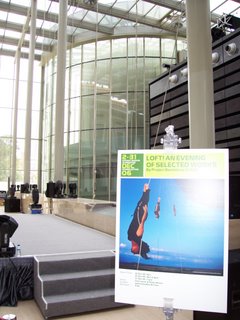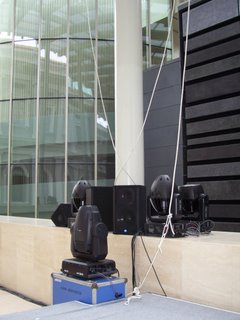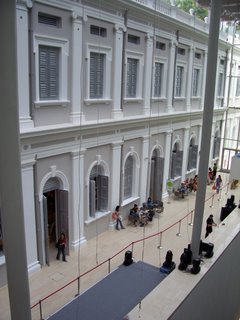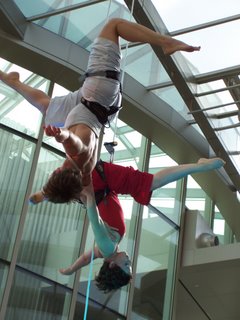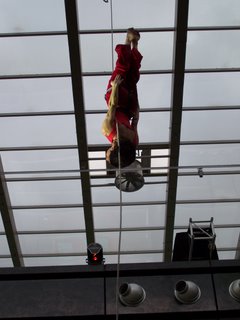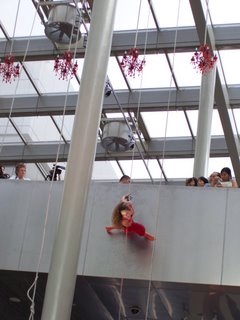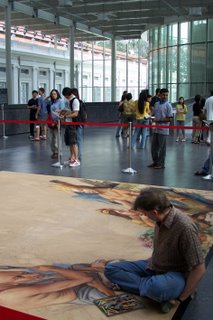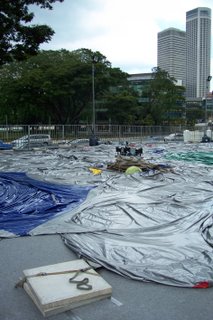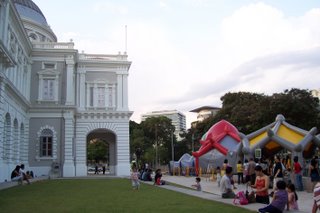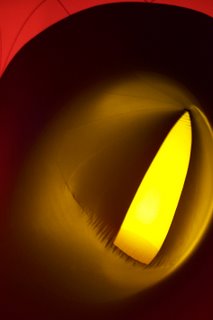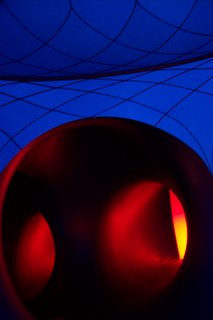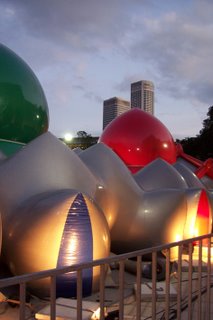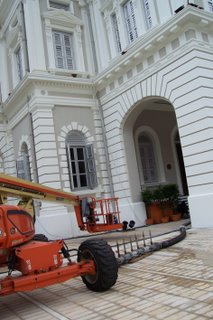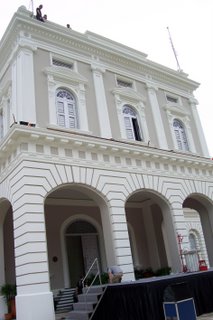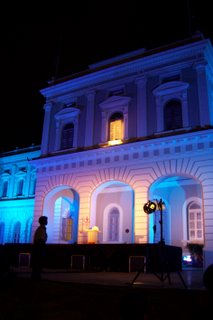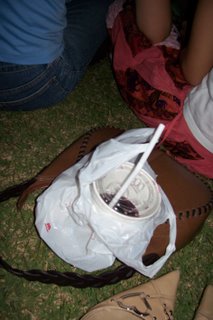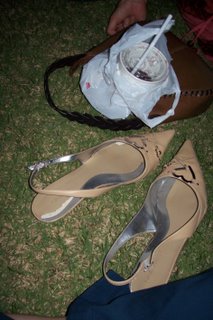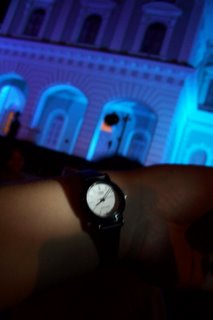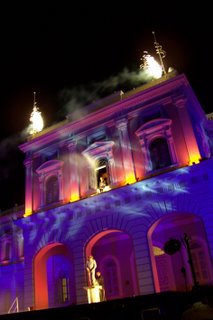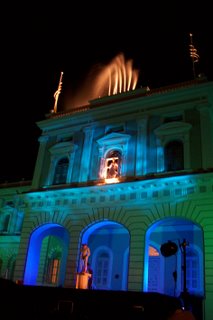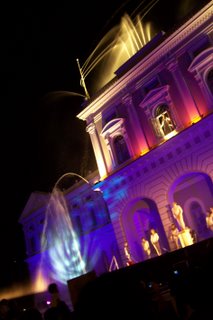 Portrait of Maria Theresia when she was a teenager.
Portrait of Maria Theresia when she was a teenager.It was fairly irrestible for me not to go for the exhibition,
Maria Theresia - Mother Empress of Habsburg Austria, held at the
National Museum of Singapore.
I felt pretty impressed after reading the ascribed capabilities of Maria Theresia from one of the publicity materials for this exhibition. Here's a snippet of the publicity materials that had caught my eye: "This exhibition will explore the intricacies and complexities faced by a woman monarch and her ingenity in tackling the challenges at a time where such vocations were considered to be a purely male dominated entity..."
In my mind, when I went on this exhibition, I sought to find out what would be the attributes that would make one a woman with the strength of character.
Prior to the exhibition, I decided that it would be a good idea to enjoy a cup of Austrian beverage at
Wiener Kaffeehaus. There's a
Wiener Kaffeehaus outlet just nearby the exhibition gallery, at the basement of the museum. I ordered hot chocolate and a piece of
Wiener Apfel Strudel. The hot chocolate was nice and it came with a piece of marshmallow. The apple strudel looked novel and I like the whipped cream that went with it.
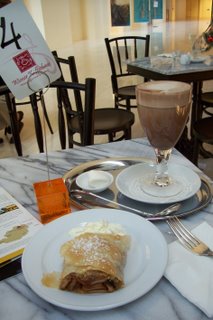
After the meal, with my ticket in my hand, I walked my way into the exhibition gallery. I felt rather disappointed when I saw the sign indicating that there would be no guided tour to the exhibition on that very day. I secretly asked myself if I should just ask for a refund and come another day. However, the Mozart music that was playing from the exhibition gallery seemed to beckon me to go in. And I shall say that I had succumbed to the power of that music.
Without a guide, and with my limited knowledge of the history of Austria and the 18th century Europe, I felt I was like a history bluff trying to make the most out of my visit to the exhibition. Nevertheless, the experience at the exhibition still turned out to be fairly rewarding. For one thing, I was treated with a continuous stream of music composed by, if I was not wrong,
Wolfgang Amadeus Mozart. The music seemed to have brought an ambience of elegance and dignity to the entire exhibition. While I was in the exhibition gallery, I also enjoyed being away from the noises of the busy city life. Other than the treats to my ears, my eyes were treated to many royal artefacts.
 The exhibit is related to the topic of the Pragmatic Sanction.
The exhibit is related to the topic of the Pragmatic Sanction.Meantime, before I write about the royal artefacts, I think it might be good to start with the
Pragmatic Sanction. I truly don't know much about it, but I do remember from my trip to the exhibition, that the Pragmatic Sanction was one of the key instruments that had eventually contributed to Maria Theresia's inheritance of the Habsburg monarchy. I had wished that I could have someone knowledgeable on the subject to be beside me then so as to fill me in with more information.
From the exhibition, I managed to gain a gist of understanding of how
Maria Theresia had been raised and educated. I also realised that she had not been raised to be a successor of the Habsburg monarchy. Her ascension to the throne was very much an unexpected one, it seemed.
This exhibition also touches on her love story with
Franz Stephan (Francis I), whom she later married and had 16 children with.
The precious metals and glamorous pearls and jewels from the replica of the Imperial Crown of the Holy Roman Empire were simply too attention-seeking to be ignored. According to what I read from one of the publicity materials, "the crown features religious figures from the Holy Book as embodiments of the virtues of justice, wisdom and faith in God - traits essential for a ruler".
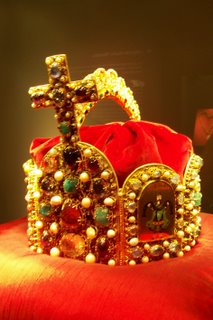 Replica of the Imperial Crown of the Holy Roman Empire
Replica of the Imperial Crown of the Holy Roman Empire As best as I could remember, on the right is the Golden Imperial Cross.
As best as I could remember, on the right is the Golden Imperial Cross.What I particularly like about this exhibition was being able to read about the various reforms that Maria Theresia had made to Education, the Army, and Healthcare. I could sense that Maria Theresia had been a diplomatic, compassionate and far-sighted ruler.
I was impressed reading about Maria Theresia as the Head of the Army. This could be found under the
Wars section. According to the notes from one of the exhibits, she's "well-known to have made extraordinary efforts to win over her soldiers with generosity". If I were to think about the context of the times that she had lived in, I could better appreciate the importance of winning the loyalty of one's soldiers. At this section of the exhibition, I found about the
Seven Years' War against Prussia and how the earning of the loyalty of her soldiers had refrained the soldiers from deserting during this difficult war.
Do check out this section to find out how Maria Theresia had won the loyalthy of her soldiers and the special privileges that Maria Theresia granted to her soldiers. My interpretations of the lessons to be drawn from this section: Going the extra mile to show one's appreciation and recognition of the efforts of those who have served one can make one's followers feel valued and earn their loyalty. Sincerity matters too.
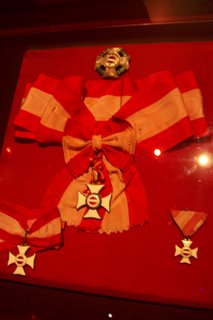
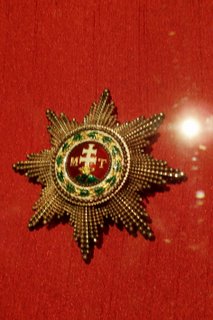 Right above: Star of the Grand Cross of the Royal Hungarian Order of St Stephan.
Right above: Star of the Grand Cross of the Royal Hungarian Order of St Stephan.After reading about the reforms that Maria Theresia had made to the Army, and about Maria Theresia as the Head of the Army, I felt more able to appreciate the value of the
Star of the Grand Cross of the Royal Hungarian Order of St Stephan. " The St Stephan's Order was founded by Maria Theresia in 1764 as a merit for senior military officers." Notice that the white Patriarchal Cross is flanked by the initials of the founder of the order.
There was a section on Maria Theresia as a devout Roman Catholic. Do check out the
Reliquary Bust of St Francis Xavier and the
Communion Chalice.
 Reliquary Bust of St Francis Xavier
Reliquary Bust of St Francis Xavier Communion Chalice
Communion ChaliceThere was a section on the Imperial family of Maria Theresia. Do find out about the political marriages of many of her children. After viewing the exhibition, I wondered if Maria Theresia's daughter,
Marie Antoinette, would have suffered the ill-fate of being executed by guillotine if she had been given the freedom to marry for love in the very first place.
Life in the palace seemed to be lavish. Words cannot exactly illustrate the point, but it might help if you look at the artefacts right below and judge for yourself.
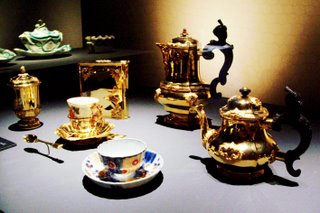 Parts of Empress Maria Theresia's Gold Breakfast Crockery.
Parts of Empress Maria Theresia's Gold Breakfast Crockery. The table setting for a fruit and dessert course.
The table setting for a fruit and dessert course.One of my favourite sections was the
Art & Culture section of the exhibition. It speaks briefly about how the Imperial family were patrons of the Art and Culture at the time. As for the rest, I shall let the photographs tell the story.
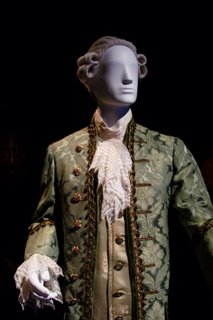

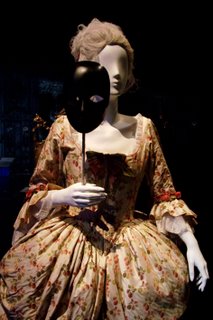
I had hoped to share a better-taken photo of a harpsichord, but the one below was the best that I could manage after several attempts. If your eyes are sharp, you may notice the three-piece
paravant in Rococo Style on the right background. Do find out what makes such frames the works of high-quality craftsmanship at the time of Maria Theresia.
 Foreground: Harpsichord
Foreground: HarpsichordAll the photographs that you see in this post are taken using non-flash photography. Please take note of the
Photography & Filming guidelines set by the National Museum of Singapore. As the use of flash and tripod is prohibited, one of the challenges I had faced was that of capturing clear shots using non-flash photography.
After the exhibition, I reflected for a brief moment. I figured that to be a woman with the strength of character, there is a high possibility that one may inevitably face many life challenges and even, resistance from others. The ingredients that could facilitate a woman to build such strength of character could be: self-discipline, being compassionate, being appreciative, time-management skills, being humble to take advice from the wiser ones, and the wisdom to make sound judgements and implement these. Perhaps there could be more. If you have other thoughts on this, please do share.
Angela has written a post about this exhibition too. Do check out her post,
A Royal Affair.
**
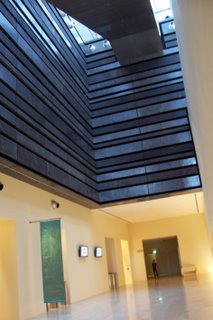 Exhibition details:
Exhibition details:
Mother Theresia - Mother Empress of Habsburg Austria
Venue: National Museum of Singapore, Changing Exhibitions Galleries
Date: 8 Dec 2006 to 31 Jan 2007
Admission Charges: $8 for adults
(Concession's available for students and NSmen.)**
You may also wish to refer to the following:
http://www.nationalmuseum.sg
http://www.nhb.gov.sg/mcc/attachments/nmphotography.jpg
http://en.wikipedia.org/wiki/Maria_Theresa_of_Austria
http://en.wikipedia.org/wiki/Pragmatic_Sanction_of_1713
http://en.wikipedia.org/wiki/Seven_Years%27_War**
Also see:
Second visit to the exhibition: Maria Theresia
